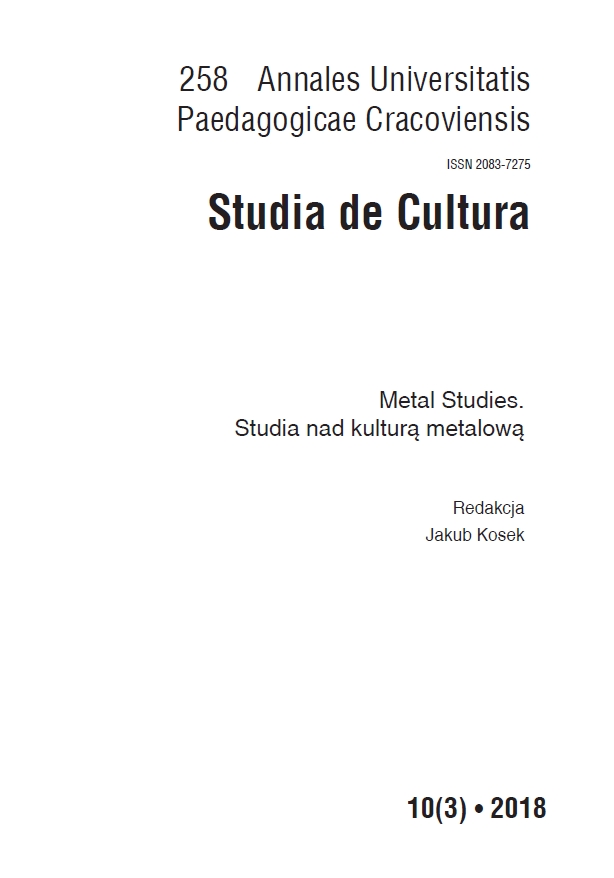Abstract
DOI 10.24917/20837275.10.3.4
Artykuł dotyczy wymowy twórczości zespołu Arija w kontekście badań nad przemianami we współczesnej kulturze rosyjskiej. Interpretacja przekazu zawartego w twórczości została poprzedzona badaniami popularności zespołu z wykorzystaniem danych statystycznych dostarczanych przez serwis trends.google. Wyniki badań świadczą o relacji między przekazem zawartym w twórczości Arii a postrzeganiem świata obecnym wśród jego odbiorców. Zauważalna w twórczości zespołu ewolucja od wartości indywidualnych poprzez krytykę egoistycznego indywidualizmu do wartości kolektywnych jest zatem związana z stanem świadomości obecnym w rosyjskim społeczeństwie i rosyjskiej kulturze czasówwspółczesnych.
The work of Aria heavy metal band in the context of research on contemporary Russian culture
The article deals with the meaning of Aria’s works in the context of research on the changes in contemporary Russian culture. Interpretation of the message contained in the works was preceded by research into the popularity of the band using the statistics provided by trends. google. The results show the relationship between the message contained in Aria’s work and the perception of the world present among his audience. Noticeable in the work of the team, the evolution of individual values through the criticism of egoistic individualism to collectivist values is therefore connected with the state of consciousness present in Russian society and Russian culture of modern times.
References
Adorno Theodor. 1992. Culture Industry, London–New York.
View in Google Scholar
Gans Herbert. 1974. Popular Culture And High Culture. An Analysis And Evaluation Of Taste. New York.
View in Google Scholar
http://www.aria.ru/publications/albums/lyrics/torero.html 2017, A [dostęp: 30.11.2017].
View in Google Scholar
http://www.aria.ru/publications/albums/lyrics/volonter.html 2017, B [dostęp: 30.11.2017].
View in Google Scholar
http://www.aria.ru/publications/albums/lyrics/vstan.html 2017, C [dostęp: 30.11.2017].
View in Google Scholar
http://www.ilyrics.ru/aria/7206-ariya-cherez-vse-vremena.html 2017, D [dostęp: 30.11.2017].
View in Google Scholar
http://www.aria.ru/publications/albums/lyrics/nasluzhbe.html 2017, E [dostęp: 30.11.2017].
View in Google Scholar
http://www.aria.ru/publications/albums/lyrics/chtovy.html 2017, F [dostęp: 30.11.2017].
View in Google Scholar
http://www.aria.ru/publications/albums/lyrics/shtill.html 2017, G [dostęp: 30.11.2017].
View in Google Scholar
http://www.aria.ru/publications/albums/lyrics/phoenix/hist-assa.html 2017, H [dostęp: 30.11.2017].
View in Google Scholar
http://www.aria.ru/publications/albums/lyrics/phoenix/phoenix.html 2017, I [dostęp: 30.11.2017].
View in Google Scholar
http://www.aria.ru/publications/albums/lyrics/phoenix/attila.html 2017, J [dostęp: 30.11.2017].
View in Google Scholar
http://www.aria.ru/publications/albums/lyrics/gerojasf.html [dostęp: 30.11.2017].
View in Google Scholar
Kidd Dustin. 2014. Pop culture freaks: identity, mass media, and socjety. Philadelphia.
View in Google Scholar
Storey John. 2003. Inventing popular culture: from folklore to globalization. Oxford–Malden.
View in Google Scholar
Süskind Patrick. 1996. Pachnidło. Historia pewnego moredercy. M. Łukasiewicz (przeł.). Warszawa
View in Google Scholar
Vaughan Liven, Chen Yue. 2015. „Data Mining From Web Search Queries: A Comparison of Google Trends and Baidu Index”. Journal Of The Association For Information Science And Technology. January 2015.
View in Google Scholar
Пушкина Маргарита. 2004. Ария Маргариты. Москва.
View in Google Scholar
Троегубов Виктор. 2005. Ария 100 страниц. Полная история к 20-летиюгруппы. Москва.
View in Google Scholar
Трой Дилан, Троегубов Виктор, Пушкина Маргарита. 2005. Ария. Легенда о Динозавре. Москва
View in Google Scholar

